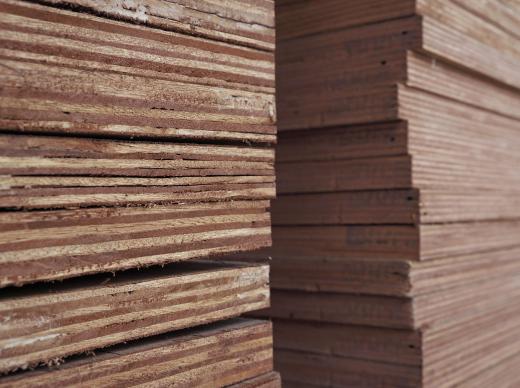A plywood saw is a device used to cut through a sheet of plywood, a type of wood consisting of multiple veneer layers that are bonded together using glue. Since plywood is usually made in large sheets, it frequently needs to be sawed into smaller components before it can be used to construct items like floors, walls, roofs, and boxes. When being cut, plywood is susceptible to becoming ragged and splintered around the edges. The use of a plywood saw can help reduce these deficiencies, allowing for a smooth end product.
Most plywood saws possess a fine-toothed blade designed to minimize tearing or shredding when cutting through a piece of plywood. Generally, a plywood saw blade is about 11 inches (approximately 28 centimeters) in length and contains about 14 teeth per inch (or per 2.54 cm). A plywood saw can be designed so that, when making a cut, it moves across the sheet of plywood. Alternatively, the saw may be structured so that the sheet of plywood is moved across the saw blade when the cut is made.

A plywood circular saw is a hand-held tool that can be used to slice through plywood. Typically, it has a plywood circular saw blade, which is a metal disk that contains teeth used to slice through the wood. In addition, the saw includes a machine which allows the disk to rotate. Using a hand-held circular saw requires a woodworker to have proper mounting devices so that cuts can be made in straight lines. Many circular saw models are portable and can be less expensive than other types of saws.

Another kind of plywood saw commonly used is the table saw. A plywood table saw works by mounting a piece of plywood on the surface of the saw table. A circular saw blade, typically powered by an electric motor, then slices through the plywood. This method can be tricky when working with large pieces of plywood, which can weigh between 70 and 100 pounds (about 32 to 45 kilograms). As a result, a woodworker generally needs to have other support mechanisms, such as extension tables, in place before cutting.
Plywood can also be cut using a vertical panel plywood cutting saw. These saws generally contain a framing device that holds the plywood in place. A guided circular saw is then moved across the plywood in order to make the cut. When used on plywood, they can work particularly well for making rough cuts. Making straight line cuts can be more difficult, however, because the cutting blade is suspended over the plywood, instead of being run across it.
